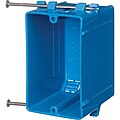Outlet boxes can be surface or sub-surface mounted. The latter type can be further divided by the type of wall it is intended for: sub-surface outlet boxes are available for mounting in drywall, in brick walls or in concrete walls.
Europe
In most of Europe, outlet boxes are round, with a standard diameter of 68 mm, to accommodate a single insert. This is often a single switch or wall socket, but inserts with two (sometimes even three) switches, a switch and an AC outlet, or two outlets (which protrudes from the wall slightly more than other inserts) are available. The round shape allows the corresponding holes to be simply drilled out with a hole saw rather than requiring a rectangular cavity to be cut out. This is an advantage especially when installing outlet boxes in brick or concrete walls, which are much more common in Europe than in North America.
Boxes intended for drywall always have parsellas, similar to the North American old work type (the distinction between old and new work is not used in Europe), as the round shape of the boxes and prevalence of light-gauge steel framing in modern drywall make nailing to a stud impractical.
Most outlet boxes can be connected to form a chain, limited in length only by the availability of faceplates for the inserts; depending on the product series, between 3 and 5 inserts can be combined in this manner. Some manufacturers also produce 2-gang, 3-gang or 4-gang boxes. The center distance between two inserts is always 71 mm.
Even with those round-hole systems, the faceplates that cover them are mostly rectangular.
Surface-mounted boxes are uncommon and surface-mounted switches or AC outlets are normally used instead.
68 mm round outlet box for drywall installation
68 mm round outlet box for installation in a brick wall, with connectors on each end to chain multiple boxes together
Four boxes connected in a row
Preparing wires in a round wall box
Belgium
Single gang boxes for installation in plasterboard are of the standard European type. Boxes for installation in brick walls are rectangular in shape and can be connected to form a chain, similar to their standard European counterparts. For plasterboard, 2-gang, 3-gang or 4-gang boxes are available instead. The center distance between inserts is 71 mm, as in most of the rest of Europe, for horizontal combinations; for vertical ones, it is 71, 60 or 57 mm. Single gang boxes, as well as multi-gang boxes or rows of boxes with a center distance of 71 mm, can accommodate standard European inserts.
British Isles
In the UK, also in Ireland, outlet boxes are rectangular. Single gang boxes have roughly the same dimensions as the European box and can accommodate European inserts, but usually not vice versa. Larger boxes are also available, to accommodate a 2-gang outlet, as well as boxes to accommodate two inserts side by side. Metal boxes, uncommon in Europe, are available in the UK. The term "back box" (or "backbox") is also often used, sometimes to refer only to a recessed/sub-surface box as distinct from a pattress, but sometimes to refer to either.
Italy
Italy uses rectangular boxes. Inserts consist of modules, with a center distance of approximately 22 mm horizontally and 45 mm vertically, although some can be double or even triple width, and a mounting frame. The size of the 3-module box, the most frequently used type, was derived from the North American single gang box and is similar enough to be used interchangeably, although Italian boxes are installed horizontally rather than vertically. Two-module boxes are similar in size to those used in Europe and the British Isles, and can be used interchangeably. Other sizes accommodate 4 modules, 7 modules, 2 rows of 3 modules or 3 rows of 6 modules. Single-module boxes are available for installation in metal profiles of modular office walls.
Like in the rest of Europe, there is no distinction between old and new work types, and drywall boxes always have parsellas. They are usually designed so that the cutout can be made with a 68 mm hole saw. Surface-mounted boxes are available, but some switches and AC outlets can be directly mounted to the wall surface without a box.
This type of wall boxes and inserts is also used in Romania and parts of North Africa.












